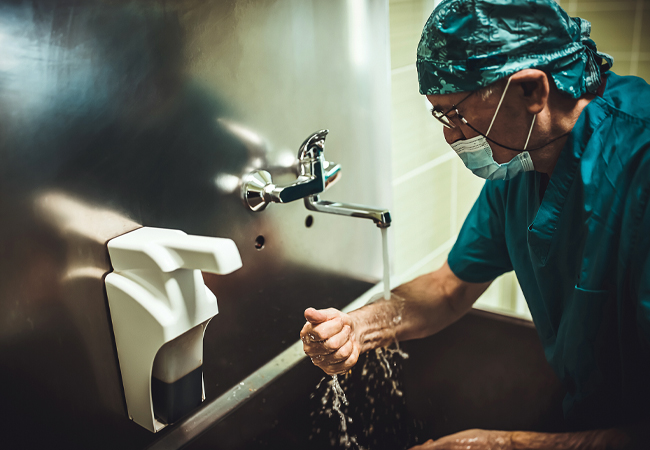
Ensuring plumbing systems are safe for vulnerable users in care homes and hospitals is crucial.
In healthcare settings this importance is magnified due to the number of patients, staff and visitors who rely on the water supply. A well-designed plumbing system protects health by preventing incidents like scalding and bacterial contamination, which poses a significant risk in healthcare environments.
Key to safe plumbing systems are water control valves that manage functions such as flow through and temperature regulation.
These solutions ensure the demands are met across the entire building, creating a safe and robust water system, which is one of the most critical foundations for hospitals and care homes. Every system must be designed to suit the complexities of everyday demands.
Understand the environment
While there are similarities in the plumbing installations of every care home and hospital, each one is unique – particularly when looking at the large-scale commercial systems. These systems are not only substantial in their scale, but also have the potential to serve hundreds – if not thousands – of people each day.
These characteristics shape the safety considerations for system specifiers and installers. Larger buildings will typically have higher water pressures for which plumbing systems will need to be equipped, while user demand will fluctuate considerably throughout the course of a day. That’s why it’s important to gain a comprehensive understanding of the environment from the start when designing safe plumbing systems.
For the best results, it is good practice to consider plumbing systems as a whole, despite the size of the hospital or care home. This ensures the correct water control valves are selected to achieve optimum results, with each performing their individual roles to cumulatively deliver safe and reliable performance.
Optimise plumbing systems for health and safety
Health and safety are priorities in healthcare facilities, with the risks of scalding and legionella contamination two of the most pressing concerns.
Thermostatic mixing valves (TMVs) are essential components in these environments, as they blend hot and cold water to create a stable outlet temperature.
Valves like the Heatguard TMV3-8 TMV are specifically approved for healthcare applications, delivering water at safe temperatures and shutting off if the cold-water supply fails to prevent unregulated temperatures being available to the user.
It is essential that TMVs that are used in healthcare environments meet the TMV3 Scheme criteria, which sees them tested against a range of pressures to ensure they meet the necessary safety standards. TMV3-approved valves also meet the strict criteria set out by the NHS D08 specification, requiring TMVs to maintain a constant outlet pressure despite any fluctuations in the temperature or pressure of the water supply.
The risks of scalding and legionella contamination are two of the most pressing concerns
Ensure the supply remains safe
When considering safe water temperatures for healthcare environments, scalding is just one part of the puzzle. At the other end of the scale, where cold water supplies can rise to ambient temperature levels, Legionnaires’ disease becomes a concern. Therefore, using solutions that can enable the delicate balance of water temperature is important in maintaining system safety.
Legionella bacteria thrive in moderate temperatures and stagnant water. If the bacteria grows and patients, staff or visitors contract Legionnaires’ disease, the consequences can be dangerous, particularly in hospitals and care homes where many people are already vulnerable and susceptible to infection.
Anti-legionella valves need to be fitted to expansion or cold-water storage tanks to prevent bacteria from contaminating a water supply. The valves continuously renew the water content to maintain circulation and prevent stagnation – removing one of the fundamental environmental characteristics that support the bacteria’s growth.
These valves will work alongside solutions such as thermal balancing valves and thermostatic mixing valves to make sure the circulating hot water temperature remains high and consistent across a building, ensuring efficiency, while safeguarding against scalding at the point of use.
Prevent backflow
The scale of care home and hospital facilities means that not only does the safety of people on site need to be considered, but in the event of contamination, even other properties using the common water supply network can be put at risk.
Backflow occurs when sudden drops in pressure force water to move in the opposite direction and ultimately contaminate the water supply. It poses a particular threat to larger care home and hospital plumbing installations.
Some occurrences of backflow are more severe than others. This is outlined through five fluid categories, with category 1 being the lowest risk and categories 4 and 5 presenting significant risk. Buildings that fall into these high-risk categories – including hospitals – must take additional precautions to minimise the potential for backflow.
To prevent it, reduced pressure zone (RPZ) valves must be installed in healthcare settings. This is achieved by ensuring that water in the system remains at a lower pressure than the incoming supply. These valves, like the commercial type BA RPZ valve, provide the highest level of mechanical protection against backflow, ensuring compliance and maintaining the required levels of safety across fluid category 4 environments.
Maintain systems regularly
Installing the appropriate valves in plumbing systems is just part of the solution. Regular maintenance performed by qualified installers is critical to ensure continued performance and to safeguard the water supply.
Given the complexity of plumbing systems in healthcare buildings, maintenance should be as straightforward as possible.
Valves should be easily accessible to minimise disruption for staff and patients. Just as incorrect installation may result in an increased risk of contamination, so too could inconsistent maintenance, making it an essential consideration for plumbing professionals supporting healthcare facilities.
About the author
Richard Bateman is product marketing manager, plumbing and heating, at Reliance Valves
